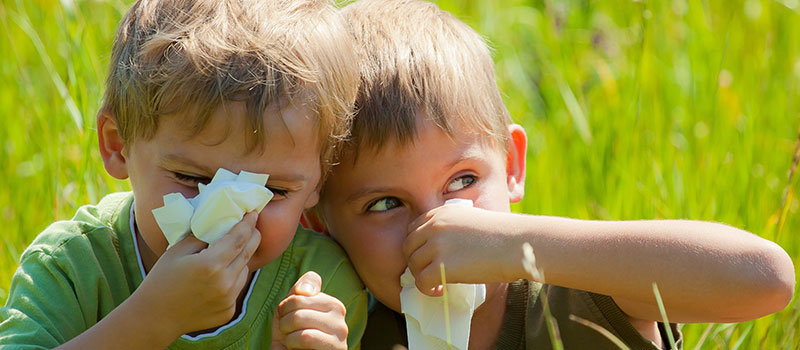If your child seems to get sinus infections every spring or sneezes around cats, it’s likely they suffer from allergies. Allergies and sinusitis are a common upper respiratory problem for children of all ages, but where do they come from? The answer is surprisingly complex.
The Biology of Allergies and Sinusitis
When our body senses an invader, like bacteria, we rely our immune systems to act fast and protect us. We have allergic reactions when our bodies react to something harmless, like pollen or pet dander, like it’s an invader.
The basic reaction to all allergens is the same:
1. Immune cells in your tissues detect an invader. They send a chemical distress signal to specialized white blood cells, called mast cells, to kick start your body’s defenses.
2. Mast cells release histamine, the immune system’s first line of defense. Histamines flood the area of the body affected by the allergen and “dock” at specialized receptors.
3. Histamine causes the body to increase blood flow to the area. This causes inflammation, including the “stuffy nose” sensation of inflamed sinuses. Histamines also cause mucus membranes to kick into high gear. The excess mucous causes sneezing, coughing and runny noses.
Sinus infections are an unfortunate but common consequence of frequent allergy symptoms. The swelling and trapped moisture in your sinuses provide an ideal breeding ground for bacteria. This makes chronic allergies go hand-in-hand with chronic sinus infections, called sinusitis.
Where Do Allergies Come From?
No one is certain why we develop allergies. There are a few factors, like genetics and our environment, that we know can play a role. The underlying cause is more mysterious. One theory suggests that today’s squeaky-clean living conditions are to blame. Without enough harmful things to train our immune system what to react to, we become too sensitive. Another theory suggests that our body may react to allergens because they’re chemically similar to harmful substances our bodies know they need to react to.
Some of the most common triggers for nasal allergies include:
• Pollen from trees, grasses and weeds
• Mold spores
• Pet dander
• Cigarette smoke
• Perfume and fragrances in things like room sprays and laundry detergents
Genetics
Genetics are a known factor in the development of allergies. In fact, there’s a 70% likelihood that identical twins with allergies will share any given triggers. Parents are likely to pass their allergies on to their children, and a child that inherits them will likely have more severe reactions and symptoms. Even the symptoms themselves can be similar. If a child’s parent or sibling is prone to chronic sinusitis, they’re 1likely to have it, too.
Environment
Environment can play a significant role in the development of allergy symptoms, especially when it comes to asthma. Children born in industrialized countries are more likely to have allergies. If they grow up in an urbanized area, allergies are even more common.
But My Child Didn’t Have Allergies Before!
You could have had a family cat since your child was born or used the same room-scenting products for years, and then suddenly your child starts sneezing every time they’re in the same room with them. Allergies can develop with repeated exposure to a potential irritant. They can also worsen over time. Your child could have been having a reaction so mild you never noticed it before. Even hormonal changes, like the onset of puberty, can trigger sudden onset allergies.
Testing for Triggers
If you think your child has allergies, talking to an ENT about allergy testing can be an excellent place to start. Allergy tests are routine, in-office testing that check the reaction of your child’s skin of a litany of potential allergens. How much they react is observed, and antihistamines are administered at the end of the test.
Knowing your child’s triggers is a good first step toward limiting their exposure to irritants. Do you need to check the day’s pollen levels along with the weather at the start of every day? Do you need to consider instituting a ‘no shoes’ rule in the house? Should you discourage your child from playing in leaf piles, which are full of allergy-triggering leaf mold? These decisions are easier when you know what you’re trying to avoid.
 Seeking Treatment
Seeking Treatment
Most allergies are treated with an oral or nasal antihistamine. These medications stop histamine from “docking” with the cells in your body, preventing the onset of symptoms. For children with severe allergies, allergy shots are an option. Allergy shots help your child’s body get used to allergens and stop overreacting upon exposure.
Your child’s ENT will advise you on the best treatment options for your child’s situation. If you’re ready to make an appointment, give Pediatric ENT of Oklahoma a call to set up a consultation or allergy testing for your child.

